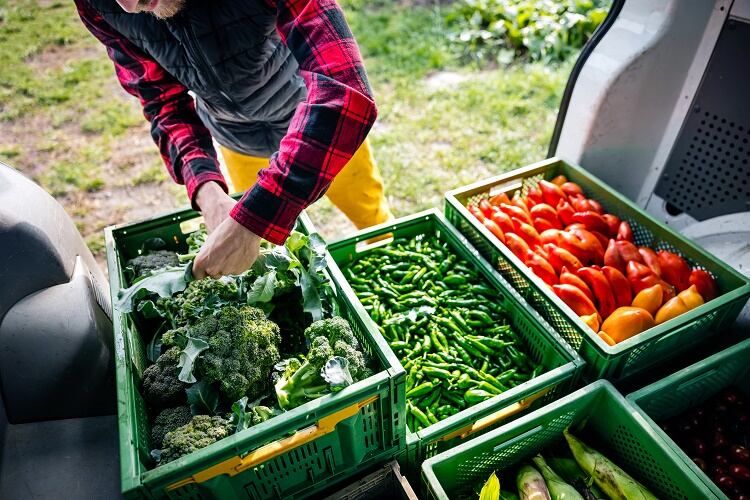The term ‘regenerative agriculture’ was first coined by organic farming organisation, the Rodale Institute, back in the 1980s. Since then, it’s slowly gained recognition by farmers and food manufacturers, proving its worth as a sustainable form of food production, essential to future food security. However, the implementation of regenerative agricultural practices has proven challenging for many farmers as it can often prove complex and costly.
“It’s not that farmers are against working in harmony with nature, they just need help making the transition,” said Peter Wortsman, partner at European Food and Farming Partnerships (EFFP), while speaking at IFE in London earlier this year. “At the moment, it feels to them that everything is being put on their shoulders.”
With that in mind, FoodNavigator travelled to a farm in the Hauts-de-France region of France, to discover how it’s working in partnership with manufacturing giant, Mondelēz International, to successfully employ regenerative agricultural practices.
What is regenerative agriculture?
While no official definition of regenerative agriculture exists in the EU, it's generally understood the term refers to principles that protect and support the surrounding environment.
These include:
- Minimising soil disturbance
- Maximising crop diversity
- Keeping soils covered
- Maintaining living roots year round
- Integrating livestock
How are farmers implementing regenerative agricultural practices?
Run by farmer, Emeric Duchesne, the 240-acre Hauts-de-France farm has been producing wheat for Mondelēz International’s Jussy biscuit factory for many years now. However, in 2014, Duchesne decided to join the Mondelēz sustainability programme, 'Harmony', and his farm has undergone some major changes as a result. So, how has the Hauts-de-France farm implemented sustainability practices under the Harmony programme?
What is Mondelēz International’s Harmony programme?
Established by Mondelēz in 2008, Harmony, is a sustainability program, dedicated to helping mitigate climate change and reverse biodiversity loss in food production.
The programme has now been adopted by more than 1,100 farmers and 18 millers across Europe, and has led to the creation of the Harmony Academy, which provides farmers with the knowledge and skills to adopt regenerative agriculture practices.
Duchesne and his team have adopted a number of new sustainable farming practices under Harmony.
The first of these being crop rotation, with sugar beet, oilseed, barley, peas and corn grown in addition to wheat, so that they can be rotated around the farm. Crop rotation helps to reduce soil erosion and increases soil fertility, resulting in naturally higher crop yields. It’s also a natural form of disease prevention, protecting crops and supporting biodiversity, as the number of chemicals required is reduced.
The farm is also improving soil cover between crops. This helps to reduce soil erosion and runoff, meaning fertile topsoil and nutrients are retained. It also helps to protect local waterways from contamination as fewer chemicals are leached from the soil into groundwater.
Reducing soil tillage, a practice that can cause soil erosion and the release of greenhouse gases into the atmosphere, has also been implemented.
If you hadn’t already guessed, the big message here is, soil matters!
But protecting biodiversity is also high on the agenda for the Harmony programme, with partner farms planting or extending hedges to provide habitats for animals and bees… although they also help to prevent soil erosion too!
Biodiversity is further supported through the identification of ecological focus areas on the farm. Here biodiversity enhancement has been supported through measures such as the installation of bee hotels to provide a sheltered and protected habitat for these small but powerful pollinators. The farm also takes part in the ‘In Harmony with Bees’ initiative, which safeguards wild bees, and engages consumers with the protection of biodiversity.
“It’s a fully dedicated job but it’s an amazing job,” says Duchesne.
But how does Mondelēz support its farmers financially?
“Mondelēz buys wheat at a premium,” explains Duchesne. This premium allows him to implement the, sometimes costly, practices involved in regenerative agriculture.
Why are bees so vital to the planet and food security?
As well as being important in their own right, bees are our greatest pollinators and, according to the UN Environment Programme, "are part of the biodiversity on which we all depend for our survival".
“Without bees, and thousands of other insect species, it would not be long before our ecosystem collapsed," says Andrew Quinn, a research scientist at the University of Lausanne. "Bees pollinate our wild trees and wildflowers, which then support other insects, which then support birds, bats, mammals and everything up the food chain, with food and shelter. Bees are also responsible for pollinating many of the crops used for animal feed, meaning that they help to support the production of meat, egg and dairy products.”
Why is regenerative agriculture important?
According to the World Health Organization (WHO), climate change, “presents a fundamental threat to human health.” It’s imperative then that we work to prevent and, if possible, reverse environmental damage, and changes within the food industry are an essential part of this.
Our global food system is one of the primary drivers of climate change, with agriculture identified as a major threat to biodiversity, impacting 24,000 of the 44,000 species currently at risk of extinction. Food production is not only one of the primary causes of wildlife loss, it is also responsible for approximately a quarter of all greenhouse gas emissions globally. Furthermore, 70% of water is used for agricultural production.
Regenerative agriculture is essential in creating a sustainable and resilient food system for a multitude of reasons.
“We are at the heart of climate change so it’s important to act now,” says Duchesne on the important role farmers possess.
Furthermore, consumers are invested in sustainability and research suggests they are willing to pay more to ensure, not just the green credentials of the products they’re buying, but also the welfare of the people involved in the production process.



